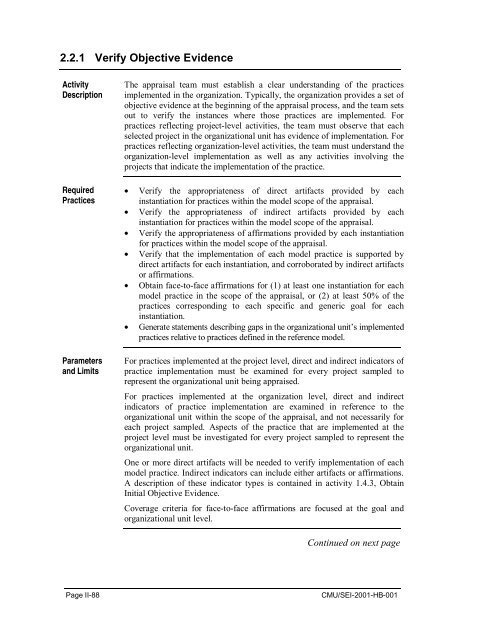Standard CMMI Appraisal Method for Process Improvement (SCAMPI)
Standard CMMI Appraisal Method for Process Improvement (SCAMPI)
Standard CMMI Appraisal Method for Process Improvement (SCAMPI)
You also want an ePaper? Increase the reach of your titles
YUMPU automatically turns print PDFs into web optimized ePapers that Google loves.
2.2.1 Verify Objective Evidence<br />
Activity<br />
Description<br />
Required<br />
Practices<br />
Parameters<br />
and Limits<br />
The appraisal team must establish a clear understanding of the practices<br />
implemented in the organization. Typically, the organization provides a set of<br />
objective evidence at the beginning of the appraisal process, and the team sets<br />
out to verify the instances where those practices are implemented. For<br />
practices reflecting project-level activities, the team must observe that each<br />
selected project in the organizational unit has evidence of implementation. For<br />
practices reflecting organization-level activities, the team must understand the<br />
organization-level implementation as well as any activities involving the<br />
projects that indicate the implementation of the practice.<br />
• Verify the appropriateness of direct artifacts provided by each<br />
instantiation <strong>for</strong> practices within the model scope of the appraisal.<br />
• Verify the appropriateness of indirect artifacts provided by each<br />
instantiation <strong>for</strong> practices within the model scope of the appraisal.<br />
• Verify the appropriateness of affirmations provided by each instantiation<br />
<strong>for</strong> practices within the model scope of the appraisal.<br />
• Verify that the implementation of each model practice is supported by<br />
direct artifacts <strong>for</strong> each instantiation, and corroborated by indirect artifacts<br />
or affirmations.<br />
• Obtain face-to-face affirmations <strong>for</strong> (1) at least one instantiation <strong>for</strong> each<br />
model practice in the scope of the appraisal, or (2) at least 50% of the<br />
practices corresponding to each specific and generic goal <strong>for</strong> each<br />
instantiation.<br />
• Generate statements describing gaps in the organizational unit’s implemented<br />
practices relative to practices defined in the reference model.<br />
For practices implemented at the project level, direct and indirect indicators of<br />
practice implementation must be examined <strong>for</strong> every project sampled to<br />
represent the organizational unit being appraised.<br />
For practices implemented at the organization level, direct and indirect<br />
indicators of practice implementation are examined in reference to the<br />
organizational unit within the scope of the appraisal, and not necessarily <strong>for</strong><br />
each project sampled. Aspects of the practice that are implemented at the<br />
project level must be investigated <strong>for</strong> every project sampled to represent the<br />
organizational unit.<br />
One or more direct artifacts will be needed to verify implementation of each<br />
model practice. Indirect indicators can include either artifacts or affirmations.<br />
A description of these indicator types is contained in activity 1.4.3, Obtain<br />
Initial Objective Evidence.<br />
Coverage criteria <strong>for</strong> face-to-face affirmations are focused at the goal and<br />
organizational unit level.<br />
Continued on next page<br />
Page II-88<br />
CMU/SEI-2001-HB-001
















